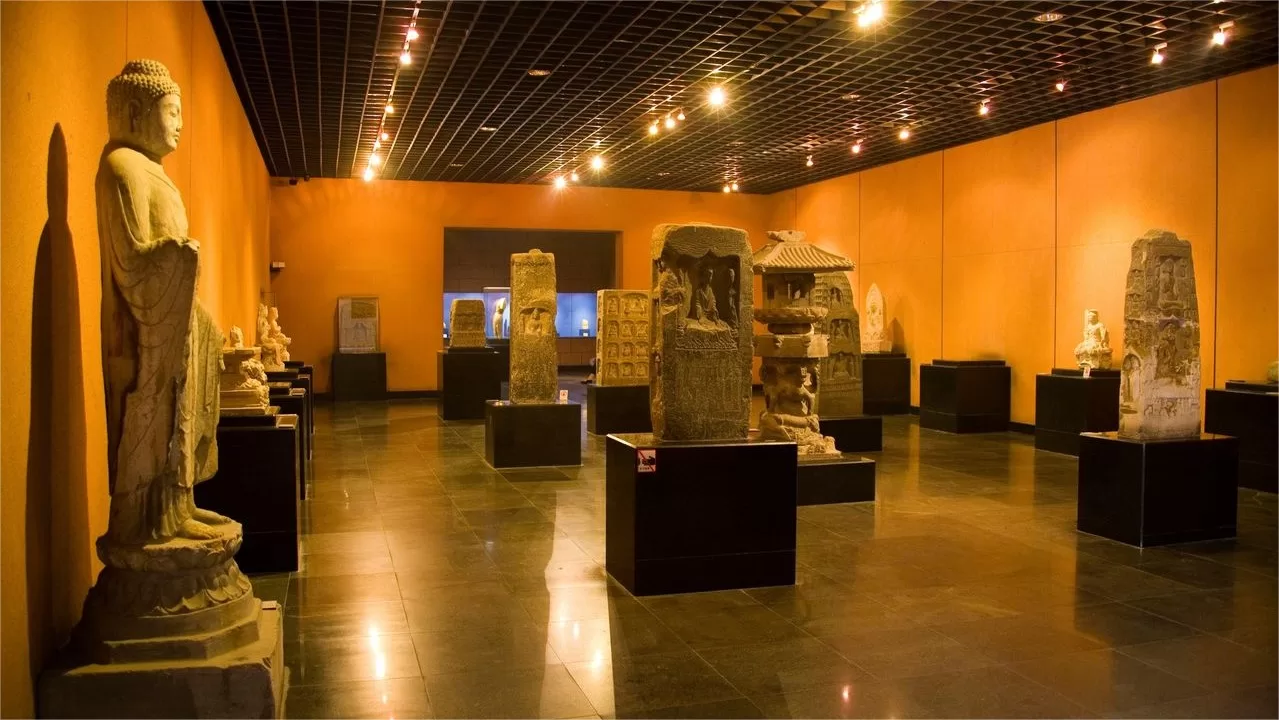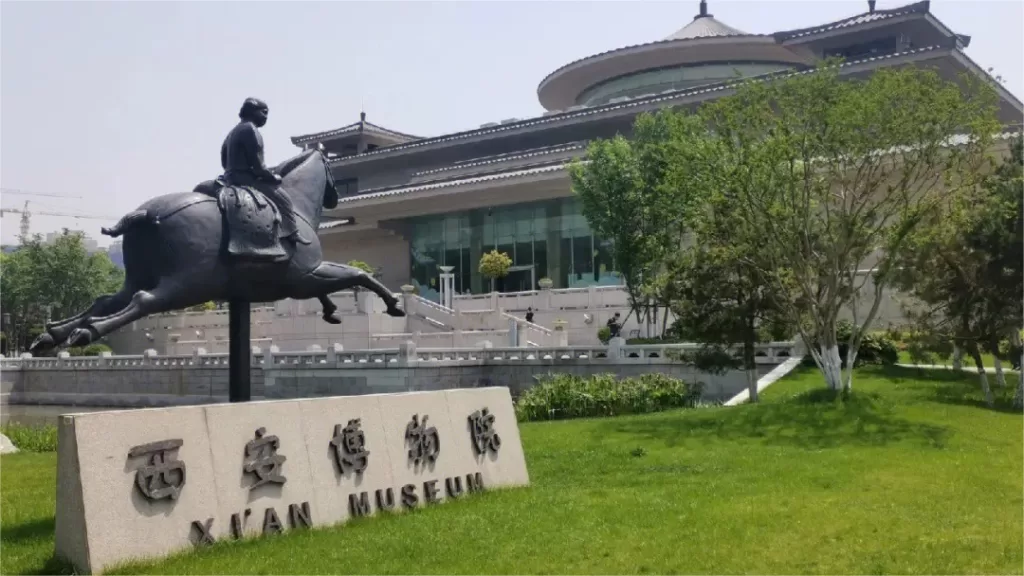The Xi’an Stele Forest Museum (西安碑林博物馆), spanning an area of 31,900 square meters, is a specialized museum dedicated primarily to the collection, research, and exhibition of stone steles, tomb inscriptions, and stone sculptures from various historical periods. Its history dates back to 1944 when it was established within the Stele Forest as a part of the Shaanxi Provincial Historical Museum.
In 1991, the Xi’an Stele Forest Museum gained its independence when the new building of the Shaanxi Provincial Historical Museum was officially opened. It separated from the provincial museum to become a distinct institution. As of the end of 2019, the museum’s collection boasts an impressive 13,568 items, including 2,281 precious cultural relics. The museum’s primary focus is on preserving and showcasing these historical treasures, making it a vital destination for those interested in Chinese history and culture.
Table of Contents
- Basic Information
- Location and Transportation
- Why Chinese carve stone stele
- Highlights of Stele Forest Museum
- Vlog about Stele Forest Museum
- History of the Stele Forest
- Useful Tips Summarized from Reviews
- Other Museums in Xi’an
Basic Information
| Website | http://www.beilin-museum.com/ |
| Estimated Length of Tour | 2 hours |
| Ticket Price | Adult: 65 yuan (1st March – 30th November) 50 yuan (1st December – 28th February the next year) Adolescent from 6 to 18 years old: 32 yuan (1st March – 30th November) 25 yuan ((1st March – 30th November) Children under 6 years old or below 1.2 meters and senior citiznes over 65 years old: free |
| Combination Ticket | Stele Forest Museum and Xi’an City Wall: 100 yuan |
| Telephone Number | 0086-029-87253331 |
Location and Transportation
The Stele Forest Museum is situated in the southern part of Xi’an, near the Shuyuanmen Street, just a few blocks away from the city center. The address is No.15 Sanxue Street, Beilin District, Xi’an, Shaanxi, China. It is easily accessible by public transportation, such as bus or metro, with several stops nearby.
Bus: Take bus 14, 23, 40, 208, 216, 221, 222, 258, 309, 402, or 800, get off at Wenchang Gate (文昌门), and walk about 400 meters to the north to reach the museum.
Subway: Take subway line 2, get off at Yongning Gate (永宁门), and walk about 600 meters to the northeast to reach the museum.
Why Chinese carve stone stele
Chinese people have a long tradition of carving stone stele for various purposes, dating back to ancient times. Stone stele are large, upright stones that are often inscribed with text or images, and they serve a range of cultural, historical, and religious functions.
One of the earliest uses of stone stele in China was to commemorate important events or people. For example, during the Zhou Dynasty (1046-256 BC), stele were often used to mark the boundaries of territories or to record the achievements of great kings and generals. Similarly, during the Han Dynasty (206 BC-220 AD), stele were used to commemorate the construction of buildings, the completion of major projects, or the achievements of scholars.
Another important use of stone stele in China was for religious purposes. Buddhist and Taoist temples often featured stele with inscriptions of sutras or teachings, and these were believed to bring good fortune or protection to those who visited the temple. Confucian temples also featured stele inscribed with the teachings of Confucius or other prominent scholars, and these were used to promote education and intellectual development.
In addition to their historical and religious functions, stone stele also had artistic and aesthetic value. Many stele were beautifully crafted with intricate designs, calligraphy, or images, and they were considered works of art in their own right.
Highlights of Stele Forest Museum
Steles throughout the History

The stele forest in Xi’an, founded in 1087, has a rich collection of stone steles and inscriptions from various historical periods. Over the centuries, it has undergone maintenance, expansions, and additions, resulting in its continuous growth and significance. The museum houses an impressive collection of over 4,000 stone steles and tomb inscriptions, making it one of the largest and most comprehensive collections in the country. These artifacts span over 2,000 years of history, beginning from the Han Dynasty.
One of the notable treasures on display in the Stele Forest Museum is the “Shi Tai Xiao Jing” (石台孝经), a stele that dates back to the fourth year of the Tang Dynasty’s Tianbao era (745 AD). This inscription was personally penned by Emperor Xuanzong (李隆基), and it is renowned as the “First Welcoming Guest Stele” due to its historical significance.
The Confucius Temple

During the Tang Dynasty, the Confucius Temple in Xi’an was originally located near the Guozijian to the west of Chang’an, the ancient capital. However, it went through several relocations during the Song Dynasty. In 1103, during the reign of Emperor Huizong, it was moved to its current location, which is within the site of the Xi’an Stele Forest Museum.
The Confucius Temple at this site still preserves several historical structures from the Ming and Qing Dynasties. These include the magnificent entrance screen wall (known as “照壁” or “Zhaobi”), archways, Lingxing Gate, ornate memorial columns (known as “华表” or “Huabiao”), a ceremonial gate (known as “戟门” or “Jimen”), a pavilion for inscribed steles (known as “碑亭” or “Beiting”), and two flanking pavilions (known as “两庑” or “Liangyun”).
Jingyun Bell

The Jingyun Bell is one of the most valuable cultural relics in the museum and is considered a masterpiece of ancient Chinese metallurgy.
The bell was cast during the Tang Dynasty (618-907 AD) and weighs over 6,000 kilograms. It is nearly 3 meters high and has a diameter of over 3 meters. The bell is inscribed with over 292 Chinese characters, including poems, songs, and prayers.
The Jingyun Bell was used to mark the time and announce important events in ancient China. It is also known for its musical qualities, producing a deep and melodious sound that can be heard from several kilometers away.
Vlog about Stele Forest Museum
History of the Stele Forest
Origins and Early Development
The origins of the Stele Forest can be traced back to the Tang Dynasty (618-907 AD). In 745 AD, during the reign of Emperor Xuanzong (Li Longji), the emperor advocated for the Confucian classic, the “Book of Filial Piety” (孝经, Xiaojing). He issued an edict mandating that every household in the empire should possess a copy of this text. To this end, he commissioned the carving of the text onto stone tablets, which were later known as the “Stone Platform Xiaojing” (石台孝经). The stone tablets were inscribed with the text in seal script, with Li Longji personally authoring the preface and annotations. The tablets were erected at the Confucian Temple within the Guozijian (Imperial Academy) in Chang’an (present-day Xi’an).
In 837 AD, another significant project, the “Kaicheng Stone Classics” (开成石经), was completed. This monumental work followed earlier stone inscriptions from the Han and Wei Dynasties and included key Confucian classics such as the “Book of Changes” (周易), “Book of Documents” (尚书), “Book of Odes” (诗经), and others. The project spanned seven years and involved the carving of 114 stones, totaling 228 surfaces of inscriptions.
Tang Decline and Relocation
The Stele Forest’s story took a dramatic turn in 904 AD during the Tang Dynasty’s decline. After Zhu Wen’s coup, which forced Emperor Zhaozong to relocate the capital to Luoyang, the city of Chang’an suffered extensive damage. To fortify the city, Han Jian, the governor of the Youguo Army, made significant changes, including shrinking the city and relocating many historical artifacts. During this period, the “Stone Platform Xiaojing” and the “Kaicheng Stone Classics” were moved to the Wenxuan Wang Temple (now located in the area of Xi’an’s Shehui Road).
In 909 AD, Liu Xiong, another prominent figure of the time, relocated the “Kaicheng Stone Classics” to the northwest corner of the Tang Shangshu Province, also in the area of Xi’an’s Shehui Road.
Song Dynasty Developments
The Song Dynasty (960-1279 AD) saw significant activity regarding the Stele Forest. Various important stone inscriptions from the Tang Dynasty were relocated to the Stele Forest. For instance, in 962 AD, Liu Congyi wrote and Ma Zhaoji inscribed the “Restoration of the Wenxuan Wang Temple Stele,” documenting the relocation of these valuable artifacts. During the Song period, the Stele Forest was further enriched with numerous new inscriptions, including works by famous calligraphers like Yan Zhenqing and Liu Gongquan.
Yuan, Ming, and Qing Dynasties
Under the Yuan Dynasty (1271-1368 AD), the Stele Forest continued to grow. The Yuan period saw the addition of inscriptions such as the “Yuan Dynasty Stone Inscriptions” and repair efforts for the damaged stelae. The Ming Dynasty (1368-1644 AD) added over 90 new inscriptions, covering a wide range of topics including historical events, poetry, and official documents. During this time, the Stele Forest gained its formal name and became a significant center for the study of epigraphy and calligraphy.
The Qing Dynasty (1644-1912 AD) brought further expansions and restorations. The early Qing period focused on maintaining and repairing existing stelae, while the later Qing period saw the inclusion of important inscriptions, such as those by Kangxi Emperor and Qianlong Emperor, which enriched the collection further.
Modern Era and Preservation
In the early 20th century, the Stele Forest faced challenges due to political and social changes. During the Republican era, additional efforts were made to preserve and catalogue the stelae. For instance, in 1918, the “Qianwei General Stele” was added to the collection, and subsequent years saw the inclusion of stelae from various historical periods.
During the 20th century, the Stele Forest continued to grow and evolve, incorporating new discoveries and inscriptions. In the 1950s, significant preservation efforts were undertaken to protect the site from further damage.
Useful Tips Summarized from Reviews
Nearby Attractions: Near the museum, you’ll find the Guanzhong Academy, where you can register at the entrance to receive tickets for a tour. This academy holds historical significance, as it was where General Peng Dehuai once delivered a report on the patriotic movement organized by Xi’an students. The architecture of the academy exudes a sense of antiquity and historical weight, and you might even encounter a friendly orange cat, adding a touch of charm to your visit.
Interactive Experience: Some of the steles (stone tablets) in the museum are accessible for touch, allowing visitors to feel the texture of history. When you touch a stele, you might contemplate the connection between yourself and the ancient people who once touched the same stone. This experience deepens your understanding of time and eternity, adding a profound dimension to your visit.
Exploring Surroundings: If you have ample time, consider strolling from the Shuyuanmen Street to the museum. Along the way, you’ll encounter various street artisans showcasing their crafts, including paper cutting, calligraphy, and traditional Chinese painting. This lively atmosphere adds to the cultural richness of your visit, providing opportunities to appreciate local artistry and craftsmanship.







The Stele Forest Museum has undergone a remarkable transformation! The angular roof combined with its vintage architecture creates a perfect blend of modernity and history. The towering residential buildings across the street create a stark contrast, leading to a strong visual impact.
Recently, the Beilin Museum in Xi’an (西安碑林) has gradually opened exhibition halls one through seven, although Hall Two featuring Mengzi is still under maintenance. The stone carving art and Buddhist statues have also been opened.
The Stele Forest Museum in Xi’an has an overwhelming number of steles, and it is currently under expansion, which means many of them are not accessible. I’ve heard that the expansion will be completed by May.